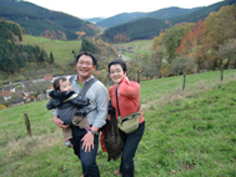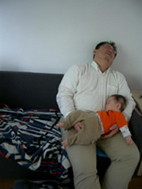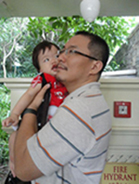Hokkaido University, Sapporo, Japan
(Updated on: May 17, 2016)
Hiroshi Nishiura, M.D., Ph.D., DTM&H
Professor
Graduate School of Medicine
Hokkaido University
Editor-in-Chief
Theoretical Biology and Medical Modelling
BioMed Central

Victoria to Peak (VTP) race, Hong Kong, 2011
Contact:
Department of Hygiene (department website is in Japanese only for now)
Graduate School of Medicine
Hokkaido University
Kita 15 Jo Nishi 7 Chome, Kita-ku
Sapporo 064-0958
Japan
Researcher profiles at ORCID and Google Scholar
Tel: +81 11 706 5065 / Fax: +81 11 706 7819
E-mail: nishiurah(at)med.hokudai.ac.jp.SPAM
(when you send me an e-mail, please replace (at) by @ and remove ".SPAM").

(Sportsoho Peak Challenge, 2012 in Hong Kong)
Interview about myself
Predicting Epidemics
BioMed Central Blog, 2015
Research Interview
Society for Mathematical Biology, 2016
Ongoing Projects
Detecting premonitory signs and real-time forecasting of pandemic using big biological data
CREST Big Data Applications, Japan Science and Technology Agency (JST)
Realizing Policymaking Process of Infectious Disease Control using Mathematical Modeling Techniques
RISTEX R&D Project: Science of Science, Technology and Innovation Policy, Japan Science and Technology Agency (JST)
Japan Agency for Medical Research and Development (AMED)
Previous Project
Innovative Model of Biological Processes and Its Development
PRESTO, Japan Science and Technology Agency (JST)
CALL! (17 May 2016)
-- Hiroshi Nishiura calls for prospective graduate students both at Master's course and PhD levels. Master of Public Health program at Hokkaido University is to be launched from 1 April 2017 (exam in August, 2016). Also, anyone wishing to work with me as postdoc or higher ranks, please do not hesitate at all to contact me. We have your desk!
Message
-- To enhance technical discussions on modeling and facilitate the use of quantitative approaches to any empirical observations, I open myself to criticisms, comments and/or suggestions for future works with others academic who share the same concern. Please send me e-mails and meet somewhere in this small world.
-- From June 2013, I have been back in Japan. If you are interested in joining our group for training infectious disease modeling, please email me your CV and two names of referees.
-- Since 1st April 2016, I have been in charge of running an independent department that excels into infectious disease modeling at Hokkaido University. The department is committed to training young scholars in ID modeling and improving regional preparedness and prevention programs against infectious disease epidemics.
Professional areas
Infectious Disease Epidemiology
Theoretical Epidemiology
Mathematical Statistics

The most stimulating blackboard in Tuebingen, Germany (2006)
Research interests
1. Disease specificities
Influenza and emerging viral infectious diseases. Smallpox and other directly transmitted diseases including diseases associated with biological threats. Vector-borne (dengue and malaria), zoonotic and vaccine preventable diseases.
2. Model preferences
Time- and age-specific transmission model (e.g. statistical models estimating the force of infection), application of maximum likelihood method and Bayesian techniques to the quantification of the intrinsic transmission dynamics (e.g., backcalculation of infectiousness and estimation of the reproduction number), modeling the incubation period of infectious diseases, modeling the generation time of infectious diseases, basic studies on the application of stochastic process, and simulation-based models specifically aimed at parameter inference.
3. Recent and greatest concerns
History of theoretical epidemiology (incl. database construction), modeling dengue with limited info, estimation of R for malaria, statistical modeling of directly transmitted diseases under approximated network structure, and mathematical studies on renewal process.



Left: Family Nishiura in Oberwolfach, Germany (November 2009): "Design and Analysis of Infectious Disease Studies"; Middle: Vietnam; Right: Australia
Recent publications (Except for papers in press, I share the copies in pdf format upon request)
new 1. Dinh L, Chowell G, Mizumoto K, Nishiura H. Estimating the subcritical transmissibility of the Zika outbreak in the State of Florida, USA, 2016. Theoretical Biology and Medical Modelling 2016;13:20 (doi: 10.1186/s12976-016-0046-1)[Journal][doi].
new 2. Otsuki S, Nishiura H. Reduced Risk of Importing Ebola Virus Disease because of Travel Restrictions in 2014: A Retrospective Epidemiological Modeling Study. PLoS One 2016;11(9):0163418 (doi:10.1371/journal.pone.0163418)[Journal][doi].
new 3. Nah K, Otsuki S, Chowell G, Nishiura H. Predicting the international spread of Middle East respiratory syndrome (MERS). BMC Infectious Diseases. 2016;16:356 (doi:10.1186/s12879-016-1675-z)[Journal][doi].
new 4. Matsuyama R, Nishiura H, Kutsuna S, Hayakawa K, Ohmagari N. PClinical determinants of the severity of Middle East respiratory syndrome (MERS): a systematic review and meta-analysis. BMC Public Health. 2016;16:1203 (doi: 10.1186/s12889-016-3881-4)[Journal][doi].
1. Nishiura H, Mizumoto K, Rock KS, Yasuda Y, Kinoshita R, Miyamatsu Y. A theoretical estimate of the risk of microcephaly during pregnancy with Zika virus infection. Epidemics 2016; 15:66-70 (doi: 10.1016/j.epidem.2016.03.001) [Journal][doi].
2. Nishiura H, Mizumoto K, Villamil-Gomez WE, Rodriguez-Morales AJ. Preliminary estimation of the basic reproduction number of Zika virus infection during Colombia epidemic, 2015-2016. Travel Medicine and Infectious Diseases. 2016; in press (doi: 10.1016/j.tmaid.2016.03.016) [Journal][doi].
3. Nah K, Mizumoto K, Miyamatsu Y, Yasuda Y, Kinoshita R, Nishiura H. Estimating risks of importation and local transmission of Zika virus infection. PeerJ. 2016;4:e1904. doi: 10.7717/peerj.1904. [Journal][doi].
4. Nishiura H, Kinoshita R, Mizumoto K, Yasuda Y, Nah K. Transmission potential of Zika virus infection in the South Pacific. International Journal of Infectious Diseases. 2016;45:95-7. doi: 10.1016/j.ijid.2016.02.017. [Journal][doi].
5. Nishiura H, Endo A, Saitoh M, Kinoshita R, Ueno R, Nakaoka S, Miyamatsu Y, Dong Y, Chowell G, Mizumoto K. Identifying determinants of heterogeneous transmission dynamics of the Middle East respiratory syndrome (MERS) outbreak in the Republic of Korea, 2015: a retrospective epidemiological analysis. BMJ Open. 2016;6(2):e009936. doi: 10.1136/bmjopen-2015-009936. [Journal][doi].
6. Kinoshita R, Nishiura H. Assessing herd immunity against rubella in Japan: a retrospective seroepidemiological analysis of age-dependent transmission dynamics. BMJ Open. 2016 Jan 27;6(1):e009928. doi: 10.1136/bmjopen-2015-009928.[Journal][doi].
7. Nishiura H, Miyamatsu Y, Mizumoto K. Objective Determination of End of MERS Outbreak, South Korea, 2015. Emerging Infectious Diseases. 2016;22(1):146-8. doi: 10.3201/eid2201.151383. [Journal][doi].
8. Mizumoto K, Endo A, Chowell G, Miyamatsu Y, Saitoh M, Nishiura H. Real-time characterization of risks of death associated with the Middle East respiratory syndrome (MERS) in the Republic of Korea, 2015. BMC Medicine 2015;13:228. doi: 10.1186/s12916-015-0468-3. [Journal][doi].
9. Chowell G, Abdirizak F, Lee S, Lee J, Jung E, Nishiura H, Viboud C. Transmission characteristics of MERS and SARS in the healthcare setting: a comparative study. BMC Medicine 2015 Sep 3;13:210. doi: 10.1186/s12916-015-0450-0.[Journal][doi].
10. Mizumoto K, Saitoh M, Chowell G, Miyamatsu Y, Nishiura H. Estimating the risk of Middle East respiratory syndrome (MERS) death during the course of the outbreak in the Republic of Korea, 2015. International Journal of Infectious Diseases 2015;39:7-9. doi: 10.1016/j.ijid.2015.08.005. [Journal][doi].
11. Nishiura H, Miyamatsu Y, Chowell G, Saitoh M. Assessing the risk of observing multiple generations of Middle East respiratory syndrome (MERS) cases given an imported case. Eurosurveillance 2015;20(27):pii=21181.[Journal].
12. Nishiura H, Kinoshita R, Miyamatsu Y, Mizumoto K. Investigating the immunizing effect of the rubella epidemic in Japan, 2012-14. International Journal of Infectious Diseases 2015;38:16-8. doi: 10.1016/j.ijid.2015.07.006. [Journal][doi].
13. Endo A, Nishiura H. Transmission dynamics of vivax malaria in the republic of Korea: Effectiveness of anti-malarial mass chemoprophylaxis. Journal of Theoretical Biology 2015;380:499-505. doi: 10.1016/j.jtbi.2015.06.024 [Journal][doi].
14. Fukami R, Nishiura H. Examining the reservoir potential of animal species for Leishmanial infantum infection. Japan Journal of Industrial and Applied Mathematics 2015;32(3):661-673. doi: 10.1007/s13160-015-0190-8 [Journal][doi].
15. Chowell G, Nishiura H. Characterizing the transmission dynamics and control of ebola virus disease. PLoS Biology 2015;13(1):e1002057. doi: 10.1371/journal.pbio.1002057.[Journal][doi].
16. Nishiura H, Chowell G. Theoretical perspectives on the infectiousness of Ebola virus disease. Theoretical Biology and Medical Modelling 2015;12:1. doi: 10.1186/1742-4682-12-1.[Journal][doi].
17. Chowell G,Nishiura H. Transmission dynamics and control of Ebola virus disease (EVD): a review. BMC Medicine 2014;12:196. doi: 10.1186/s12916-014-0196-0.[Journal][doi].
18. Cowling BJ, Ip DK, Fang VJ, Suntarattiwong P, Olsen SJ, Levy J, Uyeki TM, Leung GM, Peiris JS, Chotpitayasunondh T, Nishiura H, Simmerman JM. Modes of transmission of influenza B virus in households. PLoS One. 2014;9(9):e108850. doi: 10.1371/journal.pone.0108850. [Journal][doi].
19. Nishiura H, Chowell G. Feedback from modelling to surveillance of Ebola virus disease. Eurosurveillance 2014;19(37): pii=20908.[Journal].
20. Nishiura H, Chowell G. Early transmission dynamics of Ebola virus disease (EVD), West Africa, March to August 2014. Eurosurveillance 2014;19(36): pii=20894.[Journal].
21. Mizumoto K, Ejima K, Yamamoto T, Nishiura H. On the risk of severe dengue during secondary infection: A systematic review coupled with mathematical modeling. Journal of Vector Borne Diseases 2014;51(3):153-64 [Journal][doi].
22. Ueno R, Nishiura H. Diagnosis of a single imported dengue case who had travelled to Japan - how serious is it for travellers? Eurosurveillance 2014;19(8):pii=20715 [Journal].
23. Nabae K, Satoh H, Nishiura H, Tanaka-Taya K, Okabe N, Oishi K, Matumoto K, Hasegawa T. Estimating the risk of parvovirus B19 infection in blood donors and pregnant women in Japan. PLoS ONE 2014;9(3): e92519 (doi:10.1371/journal.pone.0092519)[Journal][doi].
24. Nishiura H, Ejima K, Mizumoto K, Nakaoka S, Inaba H, Imoto S, Yamaguchi R, Saito MM. Cost-effective length and timing of school closure during an influenza pandemic depend on the severity. Theoretical Biology and Medical Modelling 2014;11(1):5(doi:10.1186/1742-4682-11-5)[Journal][doi].
25. Ejima K, Aihara K, Nishiura H. Probabilistic differential diagnosis of Middle East respiratory syndrome (MERS) using the time from immigration to illness onset among imported cases. Journal of Theoretical Biology 2014;346:47-53(doi:10.1016/j.jtbi.2013.12.024)[Journal][doi].
26. Nishiura H, Ejima K, Mizumoto K. Missing information in animal surveillance of MERS-CoV. Lancet Infectious Diseases 2014;14(2):100 (doi:10.1016/S1473-3099(13)70699-6)[Journal][doi].
27. Zhou Y, Lau EHY, Ip DKM, Nishiura H, Leung GM, Seto WH, Cowling BJ. Years of life lost in the first wave of 2009 pandemic (H1N1) in Hong Kong. American Journal of Epidemiology 2013;178(8):1313-1318 (doi:10.1093/aje/kwt120)[Journal][doi].
28. Nishiura H, Mizumoto K, Ejima K. How to interpret the transmissibility of novel influenza A(H7N9): an analysis of initial epidemiological data of human cases from China. Theoretical Biology and Medical Modelling 2013;10:30 (doi:10.1186/1742-4682-10-30)[Journal][doi].
29. Klick B, Nishiura H, Leung GM, Cowling BJ. Optimal design of studies of influenza transmission in households. II: Comparison between cohort and case-ascertained studies. Epidemiology and Infection 2014; 142(4):744-52 (doi:10.1017/S0950268813001623)[Journal][doi].
30. Ejima K, Aihara K, Nishiura H. The impact of model building on the transmission dynamics under vaccination: Observable (symptom-based) versus unobservable (contagiousness-dependent) approaches. PLoS ONE 2013;8(4):e62062 (doi:10.1371/journal.pone.0062062)[Journal][doi].
31. Cowling BJ, Ip DKM, Fang VJ, Suntarattiwong P, Olsen SJ, Levy J, Uyeki TM, Leung GM, Peiris JSM, Chotpitayasunondh T, Nishiura H*, Simmerman JM*. Aerosol transmission is an important mode of influenza A virus spread. Nature Communications 2013;4:1935 (doi:10.1038/ncomms2922)[Journal][doi].(*joint senior author)
32. Ejima K, Aihara K, Nishiura H. Modeling the obesity epidemic: Social contagion and its implications for control. Theoretical Biology and Medical Modelling 2013;10:17 (doi:10.1186/1742-4682-10-17)[Journal][doi].
33. Mizumoto K, Ejima K, Yamamoto T, Nishiura H. Vaccination and clinical severity: Is the effectiveness of contact tracing and case isolation hampered by past vaccination? International Journal of Environmental Research and Public Health 2013;10(3):816-829 (doi:10.3390/ijerph10030816)[Journal][doi].
34. Nishiura H, Mizumoto K. Epidemiological determinants of successful vaccine development. International Journal of Medical Sciences 2013;10(4):382-384 (doi:10.7150/ijms.5689)[Journal][doi].
35. Lau LL, Ip DK, Nishiura H, Fang VJ, Chan KH, Peiris JS, Leung GM, Cowling BJ. Heterogeneity in virus shedding among medically-attended influenza A virus infections. Journal of Infectious Diseases 2013;207(8): 1281-1285 (doi: 10.1093/infdis/jit034)[Journal][doi].
36. Mizumoto K, Yamamoto T, Nishiura H. Age-dependent estimates of the epidemiological impact of pandemic influenza (H1N1-2009) in Japan. Computational and Mathematical Methods in Medicine 2013;2013:637064 (doi:10.1155/2013/637064)[Journal][doi].
37. Mizumoto K, Nishiura H, Yamamoto T. Effectiveness of antiviral prophylaxis coupled with contact tracing in reducing the transmission of the influenza A (H1N1-2009): A systematic review. Theoretical Biology and Medical Modelling 2013;10:4 (doi:10.1186/1742-4682-10-4)[Journal][doi].
38. Nishiura H, Yen HL, Cowling BJ. Sample size considerations for one-to-one animal transmission studies of the influenza A viruses. PLoS ONE 2013;8(1):e55358 (doi:10.1371/journal.pone.0055358)[Journal][doi].
39. Mizumoto K, Yamamoto T, Nishiura H. Contact behaviour of children and parental employment behaviour during school closure against the pandemic influenza A (H1N1-2009) in Japan. The Journal of International Medical Research 2013;41(3): 716-724 (doi:10.1177/0300060513478061) [Journal][doi].
40. Perera HKK, Wickramasinghe G, Cheung CL, Nishiura H, Smith DK, Poon LLM, Perera AK, Ma SK, Sunil-Chandra NP, Guan Y, Peiris JS. Swine influenza in Sri Lanka. Emerging Infectious Diseases 2013;19(3):481-484 (doi:10.3201/eid1903.120945)[Journal][doi].
41. Denes A, Kevei P, Nishiura H, Rost G. Risk of infectious disease outbreaks by imported cases with application to the European Football Championship 2012. International Journal of Stochastic Analysis 2013;2013:576381 (doi:10.1155/2013/576381) [Journal][doi].
42. Funk S, Nishiura H, Heesterbeek H, Edmunds WJ, Checchi F. Identifying transmission cycles at the human-animal interface: the role of animal reservoirs in maintaining gambiense Human African Trypanosomiasis. PLoS Computational Biology 2013;9(1):e1002855 (doi:10.1371/journal.pcbi.1002855) [Journal][doi].
43. Chowell G, Nishiura H, Viboud C. Modeling rapidly disseminating infectious disease during mass gatherings. BMC Medicine 2012;10:159 (doi:10.1186/1741-7015-10-159)[Journal][doi].
44. Omori R, Cowling BJ, Nishiura H. How is vaccine effectiveness scaled by the transmission dynamics of interacting pathogen strains with cross-protective immunity? PLoS ONE 2012;7(11): e50751 (doi:10.1371/journal.pone.0050751)[Journal][doi].
45. Nishiura H, Mizumoto K, Ejima K, Zhong Y, Cowling BJ, Omori R. Incubation period as part of the case definition of severe respiratory illness caused by a novel coronavirus. Eurosurveillance 2012;17(42):pii=20296 [Journal].
46. Chowell G, Nishiura H. Toward unbiased assessment of treatment and prevention: modeling household transmission of pandemic influenza. BMC Medicine 2012;10:118 (doi:10.1186/1741-7015-10-118)[Journal][doi].
47. Ejima K, Aihara K, Nishiura H. On the use of chance-adjusted agreement statistic to measure the assortative transmission of infectious diseases. Computational & Applied Mathematics 2013;32(2):303-313(doi:10.1007/s40314-013-0017-7)[Journal][doi].
48. Lau EHY, Nishiura H, Cowling BJ, Ip DKM, Wu JT. Scarlet Fever Outbreak, Hong Kong, 2011. Emerging Infectious Diseases 2012; 18(10): 1700-1702 (doi: 10.3201/eid1810.120062)[Journal][doi].
49. Nishiura H. Early detection of nosocomial outbreaks caused by rare pathogens: A case study employing score prediction interval. Osong Public Health and Research Perspectives 2012; 3(3): 121-127 (doi: 10.1016/j.phrp.2012.07.010)[Journal][doi].
50. Wu P, Goldstein E, Ho LM, Yang L, Nishiura H, Wu JT, Ip DKM, Chuang SK, Tsang T, Cowling BJ. Excess mortality associated with influenza A and B virus in Hong Kong, 1998-2009. The Journal of Infectious Diseases 2012; 206(12): 1862-1871 (doi:10.1093/infdis/jis628)[Journal][doi].
51. Wu P, Cowling BJ, Wu JT, Lau EHY, Ip DKM, Nishiura H. The epidemiological and public health research response to 2009 pandemic influenza A(H1N1): experiences from Hong Kong. Influenza and Other Respiratory Viruses 2013;7(3):367-382 (doi:10.1111/j.1750-2659.2012.00420.x)[Journal][doi].
52. Wong JY, Wu P, Nishiura H, Goldstein E, Lau EHY, Yang L, Chuang SK, Tsang T, Peiris JSM, Wu JT, Cowling BJ. The infection fatality risk of pandemic influenza A(H1N1) in Hong Kong in 2009. American Journal of Epidemiology 2013;177:834-840 (doi: 10.1093/aje/kws314)[Journal][doi].
53. Oei W, Nishiura H. The relationship between tuberculosis and influenza death during the influenza (H1N1) pandemic from 1918-19. Computational and Mathematical Methods in Medicine 2012; 2012: 124861 (doi:10.1155/2012/124861)[Journal][doi].
54. Cowling BJ, Nishiura H. Virus interference and estimates of influenza vaccine effectiveness from test-negative studies. Epidemiology 2012;23(6):930-931 (doi: 10.1097/EDE.0b013e31826b300e)[Journal][doi].
55. Klick B, Nishiura H, Cowling BJ. Optimal design of intervention studies to prevent influenza in healthy cohorts. PLoS One 2012;7(4):e35166 (doi:10.1371/journal.pone.0035166)[Journal][doi].
56. Ejima K, Omori R, Aihara K, Nishiura H. Real-time investigation of measles epidemics with estimate of vaccine efficacy. International Journal of Biological Sciences 2012; 8(5): 620-629 (doi: 10.7150/ijbs.4329)[Journal][doi].
57.Cowling BJ, Fang VJ, Nishiura H, Chan KH, Ng S, Ip DKM, Chiu SS, Leung GM, Peiris JSM. Increased risk of noninfluenza respiratory virus infections associated with receipt of inactivated influenza vaccine. Clinical Infectious Diseases 2012; 54(12): 1778-1783 (doi:10.1093/cid/cis307)[Journal][doi].
58. Ejima K, Omori R, Cowling BJ, Aihara K, Nishiura H. The time required to estimate the case fatality ratio of influenza using only the tip of an iceberg: Joint estimation of the virulence and the transmission potential. Computational and Mathematical Methods in Medicine 2012; 2012: 978901 (doi:10.1155/2012/978901)[Journal][doi].
59. Klick B, Nishiura H, Cowling BJ. Transmissibility of influenza. Epidemiology 2012; 23(4): 650-651 (doi: 10.1097/EDE.0b013e3182590554)[Journal][doi].
60. Lau LLH, Nishiura H, Kelly H, Ip DKM, Leung GM, Cowling BJ. Household transmission of 2009 pandemic influenza A(H1N1): a systematic review and meta-analysis. Epidemiology 2012; 23(4): 531-542 (doi:10.1097/EDE.0b013e31825588b8)[Journal][doi].
61. Lam EH, Cowling BJ, Cook AR, Wong JY, Lau MS, Nishiura H. The feasibility of age-specific travel restrictions during influenza pandemics. Theoretical Biology and Medical Modelling 2011; 8(1):44 (doi:10.1186/1742-4682-8-44)[Journal][doi].
62. Nishiura H, Yan P, Sleeman CK, Mode CJ. Estimating the transmission potential of supercritical processes based on the final size distribution of minor outbreaks. Journal of Theoretical Biology 2012; 294(1): 48-55 (doi:10.1016/j.jtbi.2011.10.039)[Journal][doi].
63. Ng S, Wu P, Nishiura H, Ip DKM, Lee EST, Cowling BJ. An analysis of national target groups for monovalent 2009 pandemic influenza vaccine and trivalent seasonal influenza vaccines in 2009-10 and 2010-11. BMC Infectious Diseases 2011;11:230 (doi:10.1186/1471-2334-11-230)[Journal][doi].
64. Klinkenberg D, Nishiura H. The correlation between infectivity and incubation period of measles, estimated from households with two cases. Journal of Theoretical Biology 2011; 284(1): 52-60 (doi:10.1016/j.jtbi.2011.06.015)[Journal][doi].
65. Kelly H, Peck HA, Laurie KL, Wu P, Nishiura H, Cowling BJ. The age-specific cumulative incidence of infection with pandemic influenza H1N1 2009 was similar in various countries prior to vaccination. PLoS One 2011;6(8):e21828 (doi:10.1371/journal.pone.0021828)[Journal][doi].
66. Nishiura H. Prediction of pandemic influenza. European Journal of Epidemiology 2011;26(7):583-584 (Letter, doi:10.1007/s10654-011-9597-y)[Journal][doi].
67. Thai KTD, Nishiura H, Hoang PH, Tran NTT, Phan GT, Le HQ, Tran BQ, Nguyen NV, de Vries PJ. Age-specificity of clinical dengue during primary and secondary infections. PLoS Neglected Tropical Diseases 2011; 5(6):e1180 (doi:10.1371/journal.pntd.0001180)[Journal][doi].
68. Klick B, Nishiura H, Ng S, Fang VJ, Leung GM, Peiris JSM, Cowling BJ. Transmissibility of seasonal and pandemic influenza in a cohort of households in Hong Kong in 2009. Epidemiology 2011; 22(6):793-6 (doi:10.1097/EDE.0b013e3182302e8e)[Journal][doi].
69. Roberts MG, Nishiura H. Early estimation of the reproduction number in the presence of imported cases: pandemic influenza H1N1-2009 in New Zealand. PLoS ONE 2011;6(5):e17835 (doi:10.1371/journal.pone.0017835)[Journal][doi].
70. Nishiura H, Chowell G, Castillo-Chavez C. Did modeling overestimate the transmission potential of pandemic (H1N1-2009)? Sample size estimation for post-epidemic seroepidemiological studies. PLoS ONE 2011; 6(3):e17908 (doi:10.1371/journal.pone.0017908)[Journal][doi].
71. Nishiura H. Real-time forecasting of an epidemic using a discrete time stochastic model: a case study of pandemic influenza (H1N1-2009). BioMedical Engineering OnLine 2011;10:15 (doi:10.1186/1475-925X-10-15) [Journal][doi].
72. Nishiura H, Kamiya K. Fever screening during the influenza (H1N1-2009) pandemic at Narita International Airport, Japan. BMC Infectious Diseases 2011;11:111 (doi:10.1186/1471-2334-11-111) [Journal][doi].
73. Omori R, Nishiura H. Theoretical basis to measure the impact of short-lasting control of an infectious disease on the epidemic peak. Theoretical Biology and Medical Modelling 2011;8:2 (doi:10.1186/1742-4682-8-2) [Journal][doi].
74. Glass K, Mercer GN, Nishiura H, McBryde ES, Becker NG. Estimating reproduction numbers for adults and children from case data. Journal of the Royal Society Interface 2011;8(62):1248-1259 (doi:10.1098/rsif.2010.0679) [Journal][doi].
75. Nishiura H, Oshitani H. Household transmission of influenza (H1N1-2009) in Japan: Age-specificity and reduction of household transmission risk by zanamivir treatment. The Journal of International Medical Research 2011;39(2):619-628 [Journal].
76. Nishiura H, Inaba H. Estimation of the incubation period of influenza A (H1N1-2009) among imported cases: Addressing censoring using outbreak data at the origin of importation. Journal of Theoretical Biology 2011;272(1):123-130 (doi:10.1016/j.jtbi.2010.12.017) [Journal][doi].
77. Nishiura H, Oshitani H. Effects of vaccination against pandemic (H1N1) 2009 among Japanese children. Emerging Infectious Diseases 2011;17(4):746-747 (doi:10.3201/eid1704.100525) [Journal][doi].
78. Nishiura H, Cook AR, Cowling BJ. Assortativity and the probability of epidemic extinction: A case study of pandemic influenza A (H1N1-2009). Interdisciplinary Perspectives on Infectious Diseases 2011;2011:194507 (doi:10.1155/2011/194507) [Journal][doi].
79. Nishiura H. Joint quantification of transmission dynamics and diagnostic accuracy applied to influenza. Mathematical Biosciences and Engineering 2011;8(1):49-64 (doi:10.3934/mbe.2011.8.49) [Journal][doi].
80. Hoye BJ, Munster VJ, Nishiura H, Klaassen M, Fouchier RAM. Surveillance of wild birds for avian influenza virus. Emerging Infectious Diseases 2010; 16(12): 1827-1834 (doi:10.3201/eid1612.100589) [Link][doi].
81. Hoye BJ, Munster VJ, Nishiura H, Fouchier RAM, Madsen J, Klaassen M. Reconstructing an annual cycle of interaction: natural infection and antibody dynamics to avian influenza along a migratory flyway. Oikos 2011;120(5):748-755 (doi:10.1111/j.1600-0706.2010.18961.x) [Link][doi].
82. Nishiura H, Omori R. An epidemiological analysis of the foot-and-mouth disease epidemic in Miyazaki, Japan, 2010. Transboundary and Emerging Diseases 2010; 57(6): 396-403 (doi:10.1111/j.1865-1682.2010.01162.x) [Link][doi].
83. Nishiura H, Roberts MG. Estimation of the reproduction number for 2009 pandemic influenza A(H1N1) in the presence of imported cases. Eurosurveillance 2010;15(29):pii=19622 (short note) [Link].
84. Nishiura H. Case fatality ratio of pandemic influenza. Lancet Infectious Diseases 2010; 10(7): 443-444 (doi:10.1016/S1473-3099(10)70120-1) [Link][doi].
85. Wada K, Nishiura H, Kawana A. An epidemiological analysis of severe cases of the influenza A (H1N1) 2009 virus infection in Japan. Influenza and Other Respiratory Viruses 2010; 4(4): 201-208 (doi:10.1111/j.1750-2659.2010.00143.x) [Link][doi].
86. Nishiura H. Time variations in the generation time of an infectious disease: Implications for sampling to appropriately quantify transmission potential. Mathematical Biosciences and Engineering 2010; 7(4): 851-869 (doi:10.3934/mbe.2010.7.851) [Link][doi].
87. Cowling BJ, Lau LLH, Wu P, Wong HWC, Fang VJ, Riley S, Nishiura H. Entry screening to delay local transmission of pandemic influenza A (H1N1). BMC Infectious Diseases 2010; 10: 82 (doi: 10.1186/1471-2334-10-82) [Link][doi].
88. Nishiura H. The virulence of pandemic influenza A (H1N1) 2009: an epidemiological perspective on the case fatality ratio. Expert Review of Respiratory Medicine 2010; 4(3): 329-338 (doi:10.1586/ers.10.24) [Link][doi].
89. Nishiura H, Satou K. Potential effectiveness of public health interventions during the equine influenza outbreak in racehorse facilities in Japan, 2007. Transboundary and Emerging Diseases 2010; 57(1): 162-170 (doi: 10.1111/j.1865-1682.2010.01134.x) [Link][doi].
90. Nishiura H. Household data from the Ugandan hepatitis E virus outbreak indicate the dominance of community infection. Clinical Infectious Diseases 2010; 51(1): 117-118 (Letter, doi:10.1086/653448) [Link][doi].
91. Nishiura H. The relationship between the cumulative numbers of cases and deaths reveals the confirmed case fatality ratio of a novel influenza A (H1N1) virus. Japanese Journal of Infectious Diseases 2010; 63(2): 154-156 [Link].
92. Nishiura H. Travel and age of influenza A (H1N1) 2009 virus infection. Journal of Travel Medicine 2010; 17(4): 269-270 (doi:10.1111/j.1708-8305.2010.00418.x) [Link][doi].
93. Nishiura H. Correcting the actual reproduction number: A simple method to estimate R0 from early epidemic growth data. International Journal of Environmental Research and Public Health 2010; 7(1): 291-302 (doi: 10.3390/ijerph7010291) [Link][doi].
94. Nishiura H, Chowell G, Safan M, Castillo-Chavez C. Pros and cons of estimating the reproduction number from early epidemic growth rate of influenza A (H1N1) 2009. Theoretical Biology and Medical Modelling 2010; 7: 1 (doi:10.1186/1742-4682-7-1)[Link][doi].
95. Reichert T, Chowell G, Nishiura H, Christensen RA, McCullers JA. Does glycosylation as a modifier of Original Antigenic Sin explain the case age distribution and unusual toxicity in pandemic novel H1N1 influenza? BMC Infectious Diseases 2010; 10: 5 (doi:10.1186/1471-2334-10-5)[Link][doi].
96. Nishiura H, Iwata K. A simple mathematical approach to deciding the dosage of vaccine against pandemic H1N1 influenza. Eurosurveillance 2009; 14(45): pii=19396 [Link].
97. Munayco CV, Gomez J, Laguna-Torres VA, Arrasco J, Kochel TJ, Fiestas V, Garcia J, Perez J, Torres I, Condori F, Nishiura H, Chowell G. Epidemiological and transmissibility analysis of influenza A(H1N1)v in a southern hemisphere setting: Peru. Eurosurveillance 2009; 14(32): pii=19299 [Link].
98. Nishiura H, Klinkenberg D, Roberts MG, Heesterbeek JA. Early epidemiological assessment of the virulence of emerging infectious diseases: A case study of an influenza pandemic. PLoS ONE 2009; 4(8): e6852 (doi:10.1371/journal.pone.0006852) [Link][Abstract][doi].
99. Nishiura H, Wilson N, Baker MG. Estimating the reproduction number of the novel influenza A virus (H1N1) in a Southern Hemisphere setting: preliminary estimate in New Zealand. The New Zealand Medical Journal 2009; 122(1299): 73-77 [Link][pdf at journal].
100. van den Broek J, Nishiura H. Using epidemic prevalence data to jointly estimate reproduction and removal. Annals of Applied Statistics 2009; 3(4): 1505-1520 (doi: 10.1214/09-AOAS270) [Link][doi].
101. Nishiura H. Excess risk of stillbirth during the 1918-20 influenza pandemic in Japan. European Journal of Obstetrics & Gynecology and Reproductive Biology 2009; 147(1): 115 (doi:10.1016/j.ejogrb.2009.07.009) [Link][doi].
102. Nishiura H, Castillo-Chavez C, Safan M, Chowell G. Transmission potential of the new influenza A (H1N1) virus and its age-specificity in Japan. Eurosurveillance 2009; 14(22): pii=19227 [Link].
103. Nishiura H, Wilson N. Transmission dynamics of the 1918 influenza pandemic in New Zealand: analyses of national and city data. The New Zealand Medical Journal 2009; 122(1296): 81-86 [Link][pdf at journal].
104. Nishiura H, Chowell G, Heesterbeek H, Wallinga J. The ideal reporting interval for an epidemic to objectively interpret the epidemiological time course. Journal of the Royal Society Interface 2010; 7(43): 297-307 (doi: 10.1098/rsif.2009.0153) [Link][doi].
105. Nishiura H, Hoye B, Klaassen M, Bauer S, Heesterbeek H. How to find natural reservoir hosts from endemic prevalence in a multi-host population: A case study of influenza in waterfowl. Epidemics 2009; 1(2): 118-128 (doi: 10.1016/j.epidem.2009.04.002) [Link][doi].
106. Nishiura H, Wilson N, Baker MG. Quarantine for pandemic influenza control at the borders of small island nations. BMC Infectious Diseases 2009; 9(1): 27 (doi:10.1186/1471-2334-9-27) [Link][doi].
107. Nishiura H. Duration of short-lived cross-protective immunity against a clinical attack of dengue: A preliminary estimate. Dengue Bulletin 2008; 32: 55-66 [Link].
108. Nishiura H, Kashiwagi T. Smallpox and season: Reanalysis of historical data. Interdisciplinary Perspectives on Infectious Diseases 2009; 59135 (doi: 10.1155/2009/591935) [Link][doi].
109. Nishiura H. Determination of the appropriate quarantine period following smallpox exposure: an objective approach using the incubation period distribution. International Journal of Hygiene and Environmental Health 2009; 212(1): 97-104 (doi: 10.1016/j.ijheh.2007.10.003) [Link].
110. Nishiura H. Epidemiologic analysis of a previous outbreak of bubonic plague: The first identified outbreak with bacteriological confirmation in Kobe and Osaka, Japan. Asian Pacific Journal of Tropical Medicine 2009; 2(1): 42-44 [Link].
111. Inaba H, Nishiura H. The state-reproduction number for a multistate class age structured epidemic system and its application to the asymptomatic transmission model. Mathematical Biosciences 2008; 216(1): 77-89 (doi: 10.1016/j.mbs.2008.08.005) [Link][doi].
112. Nishiura H, Brockmann SO, Eichner M. Extracting key information from historical data to quantify the transmission dynamics of smallpox. Theoretical Biology and Medical Modelling 2008; 4: 20 (doi:10.1186/1742-4682-5-20). [Link].
113. Nishiura H, Chowell G. Rurality and pandemic influenza: geographic heterogeneity in the risks of infection and death in Kanagawa, Japan (1918-19). The New Zealand Medical Journal 2008; 121(1284): 18-27 [Link].
114. Nishiura H. Backcalculation of the disease-age specific frequency of secondary transmission of primary pneumonic plague. Asian Pacific Journal of Tropical Medicine 2008; 1(3): 25-29 [Link][arXiv].
115. Inaba H, Nishiura H. The basic reproduction number of an infectious disease in a stable population: The impact of population growth rate on the eradication threshold. Mathematical Modelling of Natural Phenomena 2008; 3(7): 194-228 [Link][Journal].
116. Chowell G, Nishiura H. Quantifying the transmission potential of pandemic influenza. Physics of Life Reviews 2008; 5(1): 50-77 (doi: 10.1016/j.plrev.2007.12.001) [Link][arXiv].
117. Nishiura H, Chowell G. Household and community transmission of the Asian influenza A (H2N2) and influenza B viruses in 1957 and 1961. Southeast Asian Journal of Tropical Medicine and Public Health 2007; 38(6): 1075-1083 [Link].
118. Nishiura H. Time variations in the transmissibility of pandemic influenza in Prussia, Germany, from 1918-19. Theoretical Biology and Medical Modelling 2007; 4: 20 (doi:10.1186/1742-4682-4-20). [Link]
119. Nishiura H. Early efforts in modeling the incubation period of infectious diseases with an acute course of illness. Emerging Themes in Epidemiology 2007; 4: 2 (doi: 10.1186/1742-7622-4-2). [Link]
120. Satou K, Nishiura H. Transmission dynamics of hepatitis E among swine: Potential impact upon human infection. BMC Veterinary Research 2007; 3: 9 (doi:10.1186/1746-6148-3-9). [Link]
121. Nishiura H. Lessons from previous predictions of HIV/AIDS in the United States and Japan: Epidemiologic models and policy formulation. Epidemiologic Perspectives & Innovations 2007; 4: 3 (doi:10.1186/1742-5573-4-3). [Link]
122. Nishiura H. Mathematical and statistical analyses of the spread of dengue. Dengue Bulletin 2006; 30: 51-67. [Link]
123. Nishiura H, Eichner M. Interpreting the epidemiology of postexposure vaccination against smallpox. International Journal of Hygiene and Environmental Health 2008; 211(1-2): 219-226. [Link]
124. Nishiura H, Eichner M. Infectiousness of smallpox relative to disease age: Estimates based on transmission network and incubation period. Epidemiology and Infection 2007; 135(7): 1145-1150. [Link]
125. Satou K, Nishiura H. Evidence of the partial effects of inactivated Japanese encephalitis vaccination: Analysis of previous outbreaks in Japan from 1953-60. Annals of Epidemiology 2007; 17(4): 271-277. [Link]
126. Nishiura H, Halstead SB. Natural history of dengue virus (DENV)-1 and DENV-4 infections: Reanalysis of classical studies. The Journal of Infectious Diseases 2007; 195(7): 1007-1013. [Link]
127. Nishiura H, Lee HW, Cho SH, Lee WG, In TS, Moon SU, Chung GT, Kim TS. Estimates of short- and long-term incubation periods of Plasmodium vivax malaria in the Republic of Korea. Transactions of the Royal Society of Tropical Medicine and Hygiene 2007; 101(4): 338-343. [Link]
128. Lee HW, Nishiura H, Cho SH, Lee WG, In TS, Moon SU, Chung GT, Kim TS. Factors affecting delayed diagnosis of Plasmodium vivax malaria in the Republic of Korea. Research Journal of Parasitology 2007; 2(1): 72-75. [Link]
129. Chowell G, Nishiura H, Bettencourt LMA. Comparative estimation of the reproduction number for pandemic influenza from daily case notification data. Journal of the Royal Society Interface 2007; 4(12): 155-166. [Link]
130. Nishiura H, Inaba H. Discussion: Emergence of the concept of the basic reproduction number from mathematical demography. Journal of Theoretical Biology 2007; 244(2): 357-364. [Link]
131. Nishiura H. Incubation period as a clinical predictor of botulism: analysis of previous Izushi-borne outbreaks in Hokkaido, Japan, from 1951-1965. Epidemiology and Infection 2007; 135(1): 126-130. [Link]
132. Nishiura H, Eichner M. Predicting residual immunity against smallpox. The Journal of Infectious Diseases 2007; 195: 160-161 (Letter). [Link]
133. Nishiura H. Analysis of a previous smallpox vaccination study: Estimation of the time period required to acquire vaccine-induced immunity as assessed by revaccination. Southeast Asian Journal of Tropical Medicine and Public Health 2006; 37(4): 673-680. [Link]
134. Nishiura H, Leary CC. Incubation period of human prion disease. Lancet 2006; 368(9539): 913 (Correspondence). [Link]
135. Nishiura H, Eichner M. Estimation of the duration of vaccine-induced residual protection against severe and fatal smallpox based on secondary vaccination failure. Infection 2006; 34(5): 241-246. [Link]
136. Nishiura H. Epidemiology of a primary pneumonic plague in Kantoshu, Manchuria, from 1910-1911: statistical analysis of individual records collected by the Japanese Empire. International Journal of Epidemiology 2006; 35(4): 1059-1065. [Link]
137. Nishiura H, Schwehm M, Eichner M. Still protected against smallpox? Estimation of the duration of vaccine-induced immunity against smallpox. Epidemiology 2006; 17(5): 576-581. [Link]
138. Nishiura H, Dietz K, Eichner M. The earliest notes on the reproduction number in relation to herd immunity: Theophil Lotz and smallpox vaccination. Journal of Theoretical Biology 2006; 241(4): 964-967. [Link]
139. Satou K, Nishiura H. Basic reproduction number for equine-2 influenza virus A (H3N8) epidemic in racehorse facilities in Japan, 1971. Journal of Equine Veterinary Science 2006; 26(7): 310-316. [Link]
140. Nishiura H. Smallpox during pregnancy and maternal outcomes. Emerging Infectious Diseases 2006; 12(7): 1119-1121. [Link]
141. Nishiura H, Arita I, Schwehm M, Eichner M. Epidemiologic assessment of the protective effects of smallpox vaccination. American Journal of Infectious Diseases 2006; 2(1): 9-17. [Link]
142. Nishiura H, Schwehm M, Kakehashi M, Eichner M. Transmission potential of primary pneumonic plague: time inhomogeneous evaluation based on historical documents of the transmission network. Journal of Epidemiology and Community Health 2006; 60(7): 640-645. [Link]
Book chapters
1. Nishiura H. Predicting the Consequences of Social Equality: Great Progress in Social Epidemiology, but with Potential Theoretical Pitfalls (Chapter 21). In: Social Determinants of Health: Assessing Theory, Policy and Practice (Bhattacharya S, Messenger S and Overy C (Eds.)) 2010; Orient BlackSwan [Link].
2. Nishiura H, Kakehashi M, Inaba H. Two critical issues in quantitative modeling of communicable diseases: Inference of unobservables and dependent happening (Chapter 3). In: Mathematical and Statistical Estimation Approaches in Epidemiology (Chowell G, Hyman JM, Bettencourt LMA, Castillo-Chavez C (Eds.)) 2009; Springer [Link], pp. 53-87.
3. Nishiura H, Chowell G. The effective reproduction number as a prelude to statistical estimation of time-dependent epidemic trends (Chapter 5). In: Mathematical and Statistical Estimation Approaches in Epidemiology (Chowell G, Hyman JM, Bettencourt LMA, Castillo-Chavez C (Eds.)) 2009; Springer [Link], pp. 103-121.
4. Nishiura H. Maternal Outcomes in Pregnancy with Smallpox: Epidemiologic Investigations of Case Fatality, Miscarriage and Premature Birth Based on Previous Outbreaks (Chapter 5). In: Infectious Pregnancy Complications 2009; Nova Science Publishers.



(from left: June, 2009 in Utrecht; Peak tram, 2012 in Hong Kong; 1st Miyazaki Highway Memorial Half Marathon, 19?? in Miyazaki, Japan)
Award/Prize
- Award for Reports in the 2006 Japanese Joint Statistical Meeting
- JSMB Young Scholar Award, 2007 (JSMB; Japanese Society for Mathematical Biology)
- 24th Inoue Research Award for Young Scientists, 2007 (Inoue Foundation)
- Award for Research Article, Hakujikai Foundation Institute of Gerontology, 2008 (Nishiura H. Epidemiologic prediction of gastric cancer characterized by Helicobacter pylori infection and its eradication therapy: Analysis of infection-carcinogenesis-process using a mathematical model. Pre Symptomatic Medicine and Anti-aging 2008; 17(1): 121-130 (in Japanese).)
- 21st (2011) Takemi Award for Young Scientist, Takemi Memorial Trust for Life Science Research: prize awarded for contributions to cross-disciplinary research studies of infectious disease epidemiology
- 3rd Tinkiti Toyama Memorial Award for Preventive Medicine, 2014 Foundation Tokyo Kenbikyo-in
- Open Sesami Award, Research Article, Hakujikai Foundation Institute of Gerontology, 2014 (Nishiura H. Optimizing vaccination policy against influenza using a mathematical model: Identification of the cost-effective preventive strategy for protecting elderly. Pre Symptomatic Medicine and Anti-aging 2014;23:51-58)
- 2014 Toyota Physical & Chemical Research Institute Scholar, Toyota Physical and Chemical Research Institute
Financial support
- Forschungsstipendium, 2005 (Deutscher Akademischer Austauschdienst )
- Banyu Fellowship Program for Epidemiology and Biostatistics, 2006 (Banyu Life Science Foundation International)
- Research Grant for Young Investigator, JSTF, 2006 (JSTF; The Science and Technology Foundation of Japan)
- Asian Neighbors Network Program 2008, The Toyota Foundation: "Building a network for pandemic influenza response in a resource-poor rural population in Northern Thailand"
- Research Grant, The Health Care Science Institute, 2008
- JST Basic Research Programs (Precursory Research for Embryonic Science and Technology: PRESTO), Japan Science and Technology Agency (JST): "Statistical modelling of infectious diseases and their non-pharmaceutical interventions using existing informative data " from 2009-13
- 2011 Research Grant for Clinical Epidemiology and Other Related Studies, St. Luke's Life Science Institute: "Effectiveness of quarantine and isolation in the presence of correlations among variables that characterize natural history and transmission dynamics of infectious diseases"
- Research Grant 2013, Takahashi Industrial and Economic Research Foundation
- Research Grant, The Health Care Science Institute, 2013
- Financial Support for Academic Studies 2013, Sumitomo Electornic Industries Group CSR (Corporate Social Responsibility) Foundation
- 2014 Research Grant for Clinical Epidemiology and Other Related Studies, St. Luke's Life Science Institute: "Classification and estimation of the biological effects of vaccination"
- 40th (2014) Research grant on infectious disease studies, Ohyama Health Foundation: "Identification of the reservoir host for parasitic diseases"
- 2014 Research Grant, The Kudo Science Foundation: "Preventing cancer by vaccination"
- 2015 Research Grant, Institute for Health Economics and Policy (IHEP) Association for Health Economics Research and Social Insurance and Welfare: "Defining Herd Immunity"
- 2015 Research Grant, Kurozumi Medical Foundation: "Measuring influenza activity using biomarker"
- 2015 Research Grant, Daiwa Securities Health Foundation: "Modelling the risk of rubella with particular focus among adults"
Editorial boards
- Theoretical Biology and Medical Modelling, Editor-in-Chief (Link )
- PLoS ONE, Academic Editor (Link )
- Journal of Biological Systems, Editorial Board member (Link )
- Infectious Disease Modelling, Editorial Board member (Link )








